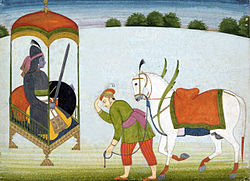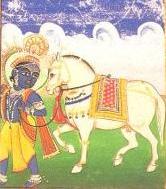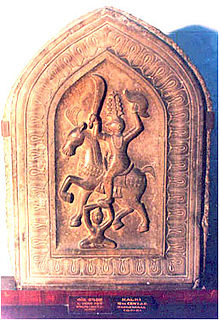|
|
Classification |
| Devanagari | no_data |
| Sanskrit Transliteration | no_data |
| Affiliation | no_data |
| Abode | no_data |
| Mantra | no_data |
| Weapon | no_data |
| Consort | no_data |
| Children | no_data |
| Mount | no_data |
In Hinduism, Kalki (Devanagari: कल्कि; meaning 'Eternity,' 'White Horse,' or 'Destroyer of Filth') is the final incarnation of Vishnu in the current Mahayuga, foretold to appear at the end of Kali Yuga, the current epoch. Religious texts called the Puranas foretell that Kalki will be atop a white horse with a drawn blazing sword. He is the harbinger of the end time in Hindu eschatology, after which he will usher in Satya Yuga.
The name Kalki is a metaphor for eternity or time. Its origins may lie in the Sanskrit word kalka which means foulness or filth. Hence, the name translates to the 'destroyer of foulness,' 'destroyer of darkness," or 'destroyer of ignorance.' Another etymology from Sanskrit is 'white horse.'
In Buddhist Kalachakra tradition, 25 rulers of the Shambhala Kingdom held the title of Kalki, Kulika or Kalki-king. During Vaishakha, the first fortnight in Shukla Paksha is dedicated to fifteen deities, with each day for a different god. In this tradition, the twelfth day is Vaishakha Dwadashi and is dedicated to Madhava, another name for Kalki.
Maha Avatara
There are numerous interpretations of Vedic tradition. Avatara means "descent" and refers to a descent of the divine into mundane form. The Garuda Purana lists ten avatars, with Kalki being the tenth. The Bhagavata Purana initially lists twenty-two avatars, but mentions an additional three for a total of twenty-five. He is presented as the twenty-second avatar on that list. Popular images depict him riding a white horse with wings, known as 'Devadatta' or God given. In these images, Kalki is brandishing a brilliant sword in his left hand, eradicating the decadence of Kali Yuga. Lord Kalki will remove the darkness of kali yuga and establish a new yuga (age) called Satya yuga (Age of Truth) on the earth. Satya yuga is also known as Krita yuga. Similarly, as per the characteristics of the next cycle of four yugas, the next satya yuga will be known as Panchorath Yuga.
Puranas
One of the earliest mentions of Kalki is in the Vishnu Purana, dated to after the Gupta Empire. The Agni Purana, one of the earliest Puranas to describe Buddha as an avatar, also describes Kalki and the end time. It draws heavily upon the Vishnu Purana in content. The Kalki Purana, a minor scripture by comparison, has the most detailed descriptions of Kalki.
Birth
As written in the Kalki Purana:
Literal translation:
शम्भल ग्राम मुख्यस्य ब्राह्मणस्य महात्मनः।
भवने विष्णुयशसः कल्किः प्रादुर्भविष्यति।।
Srimad Bhagavata Maha Purana – 12:2:18
शम्भल ग्राम मुख्यस्य ब्राह्मणस्य महात्मनः।
शम्भु Shambhu (Shiv Shambhu Bhola) + ल or ले (of) + ग्राम Grama (Community/Village) + मुख्यस्य Mukhyasya (Principally) + ब्राह्मणस्य Brahmanasya (of the Brahmins) + महात्मनः Maha Atman (Great Souls) Shiva Durga worshipping community principally of great souls Brahmins.
भवने विष्णुयशसः कल्किः प्रादुर्भविष्यति।।
भवने Bhavanê (At the home of) + विष्णु Vishnu + यशसः YáSas (Worthy) + कल्क Kalk ( Mud or Sediment) + इ i (to arise from, come from) + प्रादुर् Pradúr (Arise/Born) भविष्यति Bhavishyati (In the future)
In the future at the home of Vishnu worthy, one from the mud/sediment will arise/be born.
This points to a name equivalent to mud or sediment born.
द्वादश्यां शुक्ल-पक्षस्य माधवे मासि माधवम्।
जातं ददृशतुः पुत्रं पितरौ हृष्ट-मानसौ।। (1:2:15 Kalki Purna)
द्वादश्यां - द्वा dvA (two) + दश्यां dashya (tens/10's) meaning 12 शुक्ल-पक्षस्य - शुक्ल Shukla (bright) + पक्षस्य(pakshaya) parts (the first part of the moon cycle) + माधवे madhva is hindu month of Chaitra</a> (First day of Chaitra is when Lord Brahma created the universe, Hindu new year starts) March/April + मासि masi (month of) + माधवम् Lord Krishna (as Kalki) arrived. जातं ददृशतुः पुत्रं पितरौ हृष्ट-मानसौ।।
जातं jatam (born - brought into existence) + ददृशतुः dadastu (then) + पुत्रं putram (a son) + पितरौ pitarau (parents [were]) + हृष्ट hrshta (thrilling with rapture, rejoiced, pleased, glad, merry) + मानसौ manasau (mental feeling). or
12th of the first part of the moon cycle in the month of Chaitra (March/April, Hindu new year) Lord Krishna (as Kalki) arrived then the father was mentally overwhelmed by the son being born This also points to the sun sign of Aries. In Chaitra month, the fifteen days in Shukla paksha (first fortnight / first half of the month) are dedicated to fifteen gods or deities. Each day of the Chaitra month is dedicated to a different god. The 12th day (Chaitra Dwadashi) is dedicated to Lord Sri Maha Vishnu.
There is a description of his background in other sources of scripture. The Kalachakra tantra, first taught by Buddha to Dharmaraja Suchandra of Shambhala, also describes his background:
Lord Kalki will appear in the home of the most eminent brahmana of Shambhala village, the great souls Vishnuyasha and his wife, the pure of thought Sumati.
—Srimad-Bhagavatam Bhag.12.2.18
Vishnuyasha refers to the father of Kalki as a devotee of Vishnu while Sumati refers to His mother in Shambhala, or the temple of Shiva.
The Agni Purana predicts that at the time of his birth, evil kings will feed on the pious. Kalki will be born son of Vishnuyasha in the mythic Shambhala. He will have Yajnavalkya as his spiritual guru.
Parashurama, the sixth avatar of Vishnu is a Chiranjivi (immortal) and in scripture is believed to be alive, waiting for the return of Kalki. He will be a martial guru to the avatar, instructing him in the performance of a severe penance in order to receive celestial weaponry.
Kalki will establish moral law in the form of the fourfold varnas, and organize society into four classes, after which there will be a return to the path of righteousness. The purana also relates that Hari, will then give up the form of Kalki, return to heaven and the Krita or Satya Yuga will return as before.
The Vishnu Purana also explains:
When the practices taught in the Vedas and institutes of law have nearly ceased, and the close of the Kali age shall be nigh, a portion of that divine being who exists of His own spiritual nature, and who is the beginning and end, and who comprehends all things, shall descend upon earth. He will be born in the family of Vishnuyasha, an eminent brahmana of Shambhala village, as Kalki, endowed with eight superhuman faculties, when the eight suns (represented by 8 solar deities or Vasu who lord over Dhanishta Nakshatra) will together shine over the sky. By His irresistible might he will destroy all the mlecchas (Barbarians) and thieves, and all whose minds are devoted to iniquity. He will reestablish righteousness upon earth, and the minds of those who live at the end of the Kali age shall be awakened, and shall be as clear as crystal. The men who are thus changed by virtue of that peculiar time shall be as the seeds of human beings, and shall give birth to a race who will follow the laws of the Krita age or Satya Yuga, the age of purity. As it is said, 'When the sun and moon, and the lunar asterism Tishya, and the planet Jupiter, are in one mansion, the Krita age shall return.
—Vishnu Purana, Book Four, Chapter 24
The Padma Purana describes that Kalki will end the age of Kali and kill all mlecchas. He will gather all brahmanas and propound the highest truth, bringing back the ways of dharma that have been lost, and removing the prolonged hunger of the Brahmin. Kalki will defy oppression and be a banner of victory for the world.
The Bhagavata Purana states
At the end of Kali Yuga, when there exist no topics on the subject of God, even at the residences of so-called saints and respectable gentlemen, and when the power of government is transferred to the hands of ministers elected from the evil men, and when nothing is known of the techniques of sacrifice, even by word, at that time the Lord will appear as the supreme chastiser.
—Bhagavata Purana, 2.7.38
It goes on to foretell his arrival:
The ascetic prince, Lord Kalki, the Lord of the Universe, will mount His swift white horse Devadatta and, sword in hand, travel over the earth exhibiting His eight mystic opulences and eight special qualities of Godhead. Displaying His unequaled effulgence and riding with great speed, He will kill by the millions those thieves who have dared dress as kings.
—Bhagavata Purana, 12.2.19-20
The Kalki Purana combines elements of earlier scriptures to describe Kalki. He will have the power to change the course of the stream of time and restore the path of the righteous. The evil demon Kali will spring from the back of Brahma and descend to earth and cause dharma to be forgotten and society to decay. When man stops offering yagna, Vishnu will then descend a final time to save the steadfast. He will be reborn as Kalki to a Brahmin family in the city of Shambhala.
Followers of Tibetan Buddhism have preserved the Kalachakra Tantra in which "Kalkin" is a title of 25 rulers in the mystical realm of Shambhala. This tantra mirrors a number of prophecies of the Puranas.
Padma
Padma will be the consort of the avatar, as written in the Kalki Purana:
Kalki Purna:
मत्तो विद्यां शिवाद् अस्त्रं लब्ध्वा वेद-मयं शुकम्।
सिंहले च प्रियां पद्मां धर्मान् संस्थापयिष्यसि।। 1:3:9 ततो दिग्-विजये भूपान् धर्म-हीनान् कलि-प्रियान्।
निगृह्य बौद्धान् देवापिं मरुञ् च स्थापयिष्यसि।। 1:3:10 श्रुत्वेति वचनं कल्किः शुकेन सहितो मुदा।
जगाम त्वरितो ऽश्वेन शिव-दत्तेन तन्मनाः।। 2:1:39 समुद्र-पारम् अमलं सिंहलं जलसंकुलम्। («=सिंहलद्वीप»)
नाना-विमान-बहुलं भास्वरं मणि-काञ्चनैः।। 2:1:40 प्रासादसदनाग्रेषु पताका-तोरणाकुलम्।
श्रेणी-सभा-पणाट्ताल-पुर-गोपुर-मण्दितम्।। 2:1:41
The beloved of Kalki who is incarnation of Lakshmi lives at द्वीप dweep (island) सिंहले Sinha (सिंह shiha (Lion) + ले(of))= "the island of the lion"(1:3:9).
The spotless/clean land of the one which is surrounded by an excellent/supreme ocean at the other side of this ocean. Brilliant in wealth, education, powerful and prosperity island of the lion. The Lion City island country guard by heavenly lion from Paradise.
Kalki Avatar according to Sikhism

Kalki Avatar Punjab Hills, Guler, c. 1765.
Kalki was described by Guru Gobind Singh in Sri Dasam Granth. Kalki is also mentioned the oral traditions of Guru Gobind Singh known as the sau sakhis, and possibly the Sarbloh Granth. He is foretold to return on horseback with sword, manifesting himself at the village Sambhal and sounding his trumpet before fighting the wicked.
Gobind Singh writes in the Sri Dasam Granth:
When there is incest, adultery, atheism, hatred of religion, no more dharma, and sin everywhere, the impossible Iron Age has come; in what way the world will be saved? For the helpless, the Lord Himself will manifest as the Supreme Purusha. He will be called the Kalki incarnation and will be glorious like a lion coming down from heaven.
The return of Kalki in Sikhism is also predicted to be the end of the "Iron Age" and beginning of end time.
Predictions about his birth and time of arrival
Modern scholars have attempted to link recent history to Kalki. Given the traditional account of the Kali Yuga, which will last 432,000 years, and began in 3102 BCE, scholar such as Sri Yukteswar Giri have claimed there are smaller cycles within the larger 432,000 year revolution.
The Kalki Purana describes the time of his birth:
शम्भल ग्राम मुख्यस्य ब्राह्मणस्य महात्मनः
भवने विष्णुयशसः कल्किः प्रादुर्भविष्यति
भवने विष्णुयशसः कल्किः प्रादुर्भविष्यति
द्वादश्यां शुक्ल-पक्षस्य माधवे मासि माधवम्
जातं ददृशतुः पुत्रं पितरौ हृष्ट-मानसौ

Kalki with his white horse Devadatta
The Puranas describe the date as twenty-one fortnights from the birth of Krishna, which itself falls on Janmashtami in August. This would put his descent at Vaishakha, between April and May. At this time, the father of Kalki is foretold to be overwhelmed by the incarnation of Godhead that he sees as his son. This places Kalki under the sun sign of Aries.
The Bhavishya Purana foretells:
The Savior of the entire universe, Maha Vishnu
will be born on Margashirsha Month, Krishna Ashtami
8th day after the full-moon day.
—Bhavishya Purana, Canto IV, Chapter 23, Text 15
There have been a range of dates predicted, purportedly from different methods of calculation. Sri Potuluri Virabrahmendra Swami, for example, wrote 400 years ago in his Divya Maha Kala Gnana, or 'Divine Knowledge of the Time,' that Kalki would arrive when the moon, sun, Venus and Jupiter entered the same sign. This is not a rare occurrence and last happened in early 2012, passing without event. The time of arrival of Kalki has not been consistently asserted by astrologers.
People who have claimed to be Kalki

Dashavatara: (from left) Matsya, Kurma, Varaha, Narasimha, Vamana, Parashurama, Rama,Krishna,Buddha, Kalki.
References
- ^ "The Kalki Purana". Ismaili.net. Retrieved 2013-01-20.
- ^ "Appearance of Kalki Avatar". yoga-philosophy.com. 2003. Retrieved 2008-06-15.
- ^ "Kalachakra History". International Kalachakra Network. 2006-07-29. Retrieved 2008-06-15.
- ^ Wilson, Horace (2001). Vishnu Purana. Ganesha Publishing. p. 72. ISBN 1-86210-016-0.
- ^ Agni Purana. pp. 16.7–9.
- ^ Agni Purana. p. 16.10.
- ^ Padma Purana. pp. 6.71.279–282.
- ^ "Bhaktivedanta VedaBase". Vedabase.net. Retrieved 2013-01-20.
- ^ The Indus Script and the Rg-Veda, Page 16, By Egbert Richter-Ushanas, ISBN 81-208-1405-3
^ The Holy Science, by Jnanavatar Swami Sri Yukteswar Giri, Yogoda Sat-Sanga Society of India, 1949
- ^ Astrology of the Seers, Lotus Press, Twin Lakes, Wisconsin ISBN 0-914955-89-6
- ^ a b Chandra, Suresh (Aug 15, 2012). Encyclopaedia of Hindu Gods and Goddesses. Kindle Edition.
- ^ Santanu Acharya. "Hindu Prophecies: Translations from the Kalki Purana". Ww-iii.tripod.com. Retrieved 2013-01-20.
- ^ Momen, Moojan (1990). "Hindu Prophecies". Hinduism and the Bahá'í Faith. Oxford: George Ronald. ISBN 0-85398-299-6.
- ^ Buck, Christopher (2004). "The eschatology of Globalization: The multiple-messiahship of Baha'u'llah revisited". In Sharon, Moshe. Studies in Modern Religions, Religious Movements and the Babi-Baha'i Faiths. Boston: Brill. pp. 143–178. ISBN 90-04-13904-4.
- ^ The Baha'i Faith in India: A Developmental Stage Approach by William Garlington, Occasional Papers in Shaykhi, Babi and Baha'i Studies, No. 2 (June, 1997)
- ^ Juergensmeyer, Mark (2006). Oxford Handbook of Global Religions. Oxford: Oxford University Press. p. 520. ISBN 978-0-19-513798-9, ISBN (Ten digit): 0195137981.
| Data Arrangement, Technical Arrangement & Graphics |
|---|
| ♦ Guruji Murugan Chillayah - Silambam Asia |
| |
| References ( Kalki ) |
|---|
| ♦ no_data |
| ♦ no_data |
|










